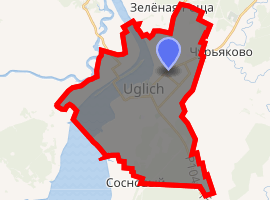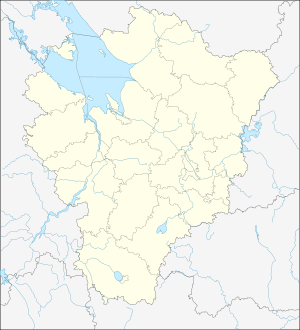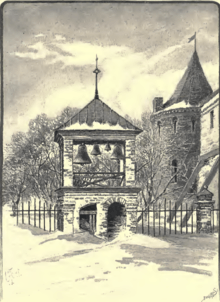Uglich
Uglich (Russian: Углич, IPA: [ˈuɡlʲɪtɕ]) is a historic town in Yaroslavl Oblast, Russia, located on the Volga River. Population: 34,507 (2010 Census);[4] 38,260 (2002 Census);[9] 39,975 (1989 Census).[10]
Uglich Углич | |
|---|---|
Town[1] | |
Uglich in winter, 2003 | |
.png) Flag .png) Coat of arms | |
Location of Uglich 
| |
 Uglich Location of Uglich  Uglich Uglich (Yaroslavl Oblast) | |
| Coordinates: 57°32′N 38°20′E | |
| Country | Russia |
| Federal subject | Yaroslavl Oblast[1] |
| Founded | 937 or 1148 |
| Government | |
| • Body | Municipal Council[2] |
| • Mayor | Eleanora Sheremetyeva |
| Area | |
| • Total | 26.6 km2 (10.3 sq mi) |
| Elevation | 120 m (390 ft) |
| Population | |
| • Total | 34,507 |
| • Estimate (2018)[5] | 32,057 (-7.1%) |
| • Density | 1,300/km2 (3,400/sq mi) |
| • Subordinated to | town of oblast significance of Uglich[1] |
| • Capital of | Uglichsky District[1], town of oblast significance of Uglich[1] |
| • Municipal district | Uglichsky Municipal District[6] |
| • Urban settlement | Uglich Urban Settlement[6] |
| • Capital of | Uglichsky Municipal District, Uglich Urban Settlement[6] |
| Time zone | UTC+3 (MSK |
| Postal code(s)[8] | 152610 |
| Dialing code(s) | +7 48532 |
| OKTMO ID | 78646101001 |
| Website | www |
History
A local tradition dates the town's origins to 937. It was first documented in 1148 as Ugliche Pole (Corner Field). The town's name is thought to allude to the nearby turn in the Volga River, and is derived from the Russian word ugol (a corner, a nook).[11]
From 1218 until 1328, Uglich was the seat of a small princedom. At that time, the local princes sold their rights to the great prince of Moscow. Uglich was a border town of the Grand Duchy of Moscow, and it was burned several times in conflicts by Lithuanians, Tatars, and the grand prince of Tver.
Grand Duke Ivan III of Moscow gave the town in 1462 to his younger brother Andrey Bolshoy (Andrey the Great). During Andrey's reign, the town was expanded and the first stone buildings were constructed. Particularly notable were the cathedral (rebuilt in 1713), the Intercession Monastery (destroyed by the Bolsheviks in the early 20th century Revolution), and the red-brick palace of the prince (completed in 1481 and still standing).
Reign of Ivan the Terrible
During the reign of Ivan the Terrible, the town passed to his only brother, Yury. Local inhabitants helped the Tsar capture the city of Kazan by building a wooden fortress that was transported via the Volga all the way to Kazan. Throughout the 16th century, Uglich prospered both politically and economically, but thereafter its fortunes began to decline.
Death of Tsarevich Dmitry
After Ivan's death, his youngest son Dmitry Ivanovich was banished to Uglich in 1584. The most well-known event in the town's history took place on May 15, 1591 when the 10-year-old boy was found dead with his throat cut in the palace courtyard. Suspicion immediately fell on the tsar's chief advisor, Boris Godunov. Official investigators concluded, however, that Dimitriy's death was an accident. They cut a "tongue" from the cathedral bell that rang the news of Dimitriy's death and "exiled" it to Siberia.
As Dimitry was the last scion of the ancient Rurik Dynasty, his death precipitated the dynastic and political crisis known as the Time of Troubles. People readily believed that Dmitry was alive and supported several False Dmitrys (see False Dmitry I, False Dmitry II, False Dmitry III), who each tried to grab the Muscovite throne. During the Time of Troubles, Poles besieged the Alexeievsky and Uleima monasteries and burned them down, killing all the populace who had sought refuge inside.
The Romanov Tsars quickly arranged to canonize the martyred Tsesarevich and to designate Uglich as a place of pilgrimage. On the spot where Dimitry was thought to have been murdered, the city in 1690 built a small Church of St. Demetrios on the Blood. Its red walls and blue domes are visible as travelers go north on the Volga. The palace where the prince lived was turned into a museum. The image of Tsesarevich with a knife in his hand was adopted as the town's coat of arms.
Later history
In the first third of the 18th century, the kremlin cathedral and its remarkable bell tower were demolished and rebuilt. Other 18th-century landmarks include the Smolenskaya, Korsunskaya, Kazanskaya and Bogoyavlenskaya churches. The most important edifice of the 19th century is the cathedral of the Theophany Convent, consecrated in 1853.
Infrastructure improvements included a railway station, connecting residents to transportation via other routes than the river. A watch manufacturing plant operated in the 20th-century town, making Chaika watches; this has since closed. A hydroelectric power station was built under Stalin's reign to generate power from the Volga. But development of the dam and Uglich Reservoir resulted in severe flooding of the town's outskirts. In November 2008 the Nexans cable mill opened.
Administrative and municipal status
Within the framework of administrative divisions, Uglich serves as the administrative center of Uglichsky District, although it is independent of it.[1] As an administrative division, it is incorporated separately as the "town of oblast significance of Uglich"—an administrative unit with the status equal to that of the districts.[1] As a municipal division, the town of oblast significance of Uglich is incorporated within Uglichsky Municipal District as Uglich Urban Settlement.[6]
Architecture
Apart from the kremlin, the city center features other examples of historic Russian architecture. Particularly notable are the Alexeievsky and Resurrection monasteries. The Assumption three-tented church (1628) of the Alexeyevsky Monastery is considered a gem of Russian medieval architecture. The common people said this church was "Marvelous", and that qualifier became part of its official name. Located nearby is the more conventional Church of St. John the Baptist (1681).
Closer to the bank of the Volga is the Resurrection Monastery with a huge cathedral, refectory, belfry, and summer church. All these buildings stand in a row and date to 1674-77. Opposite the monastery is the graceful Church of the Nativity of St. John the Baptist. It was built in 1689-90 by a local merchant to commemorate the spot where his son had drowned.
More historic architecture may be seen in the vicinity of Uglich, including the 17th-century Uleima Monastery and a fine church in Divnogorye.
References
Notes
- Law #12-z
- Муниципальный Совет
- РОССТАТ Территориальный орган Федеральной службы государственной статистики по Ярославской области Ярославская область в цифрах 2012. Краткий статистический сборник. г. Ярославль 2012 год
- Russian Federal State Statistics Service (2011). "Всероссийская перепись населения 2010 года. Том 1" [2010 All-Russian Population Census, vol. 1]. Всероссийская перепись населения 2010 года [2010 All-Russia Population Census] (in Russian). Federal State Statistics Service.
- "26. Численность постоянного населения Российской Федерации по муниципальным образованиям на 1 января 2018 года". Federal State Statistics Service. Retrieved January 23, 2019.
- Law #65-z
- "Об исчислении времени". Официальный интернет-портал правовой информации (in Russian). June 3, 2011. Retrieved January 19, 2019.
- Почта России. Информационно-вычислительный центр ОАСУ РПО. (Russian Post). Поиск объектов почтовой связи (Postal Objects Search) (in Russian)
- Russian Federal State Statistics Service (May 21, 2004). "Численность населения России, субъектов Российской Федерации в составе федеральных округов, районов, городских поселений, сельских населённых пунктов – районных центров и сельских населённых пунктов с населением 3 тысячи и более человек" [Population of Russia, Its Federal Districts, Federal Subjects, Districts, Urban Localities, Rural Localities—Administrative Centers, and Rural Localities with Population of Over 3,000] (XLS). Всероссийская перепись населения 2002 года [All-Russia Population Census of 2002] (in Russian).
- "Всесоюзная перепись населения 1989 г. Численность наличного населения союзных и автономных республик, автономных областей и округов, краёв, областей, районов, городских поселений и сёл-райцентров" [All Union Population Census of 1989: Present Population of Union and Autonomous Republics, Autonomous Oblasts and Okrugs, Krais, Oblasts, Districts, Urban Settlements, and Villages Serving as District Administrative Centers]. Всесоюзная перепись населения 1989 года [All-Union Population Census of 1989] (in Russian). Институт демографии Национального исследовательского университета: Высшая школа экономики [Institute of Demography at the National Research University: Higher School of Economics]. 1989 – via Demoscope Weekly.
- Brumfield , W. (July 12, 2019). "Resurrection Monastery in Uglich: Architectural jewel in chaotic times". Russia Beyond the Headlines. Retrieved January 29, 2020.
- Kennan, George (1891). Siberia and the Exile System. London: James R. Osgood, McIlvaine & Co. pp. 420–422, 427.
Sources
- Государственная Дума Ярославской области. Закон №12-з от 7 февраля 2002 г «Об административно-территориальном устройстве Ярославской области и порядке его изменения», в ред. Закона №67-з от 21 декабря 2012 г. «О внесении изменений в отдельные законодательные акты Ярославской области и признании утратившими силу отдельных законодательных актов (положений законодательных актов) Ярославской области». Вступил в силу через шесть месяцев со дня официального опубликования. Опубликован: "Губернские вести", №11, 15 февраля 2002 г. (State Duma of Yaroslavl Oblast. Law #12-z of February 7, 2002 On the Administrative-Territorial Structure of Yaroslavl Oblast and on the Procedures of Its Change, as amended by the Law #67-z of December 21, 2012 On Amending Various Legislative Acts of Yaroslavl Oblast and on Abrogation of Various Legislative Acts (Clauses of Legislative Acts) of Yaroslavl Oblast. Effective as of the day six months from the day of the official publication.).
- Государственная Дума Ярославской области. Закон №65-з от 21 декабря 2004 г. «О наименованиях, границах и статусе муниципальных образований Ярославской области», в ред. Закона №59-з от 28 декабря 2011 г «Об изменении статуса рабочего посёлка Песочное Рыбинского района и о внесении изменений в отдельные законодательные акты Ярославской области». Вступил в силу через 10 дней со дня официального опубликования. Опубликован: "Губернские вести", №70, 23 декабря 2004 г. (State Duma of Yaroslavl Oblast. Law #65-z of December 21, 2004 On the Names, Borders, and Status of the Municipal Formations of Yaroslavl Oblast, as amended by the Law #59-z of December 28, 2011 On Changing the Status of the Work Settlement of Pesochnoye of Rybinsky District and on Amending Various Legislative Acts of Yaroslavl Oblast. Effective as of after 10 days from the day of the official publication.).
External links
| Wikivoyage has a travel guide for Uglich. |
- (in Russian) Landmarks of Uglich
- (in Russian) More landmarks of Uglich
- Chisholm, Hugh, ed. (1911). . Encyclopædia Britannica (11th ed.). Cambridge University Press.
